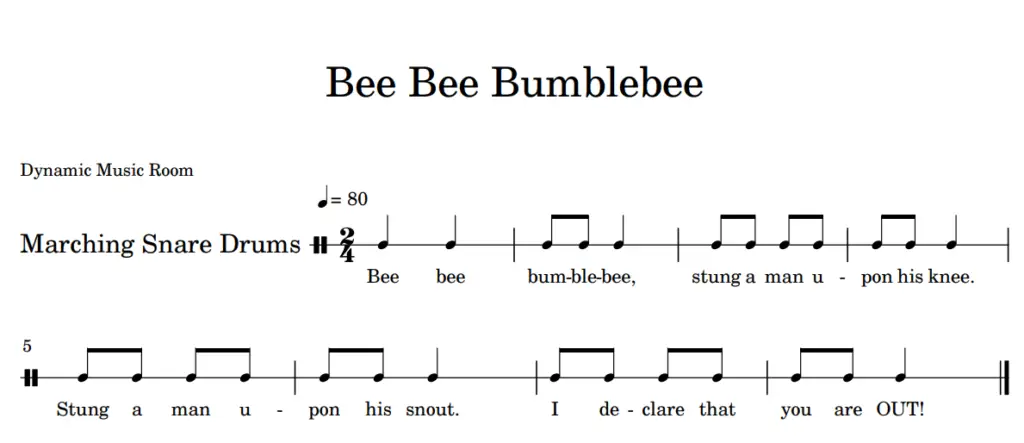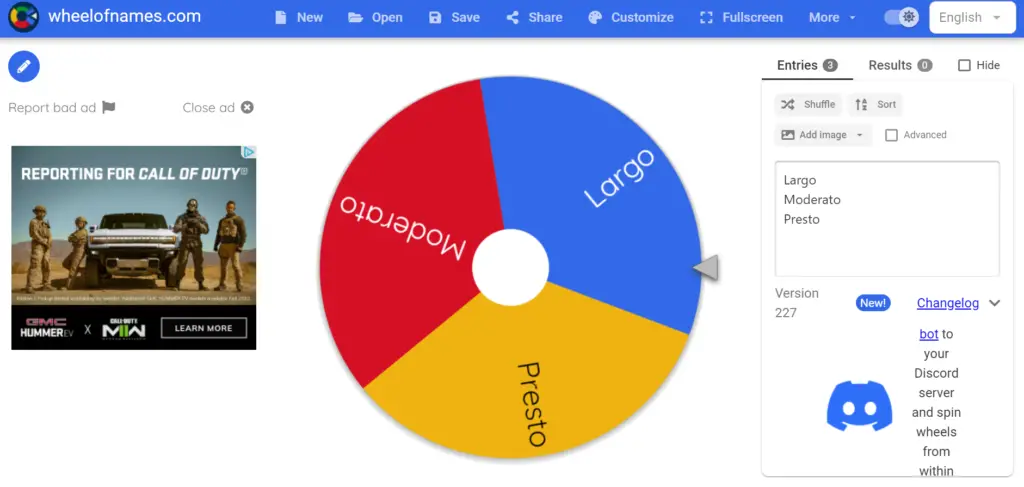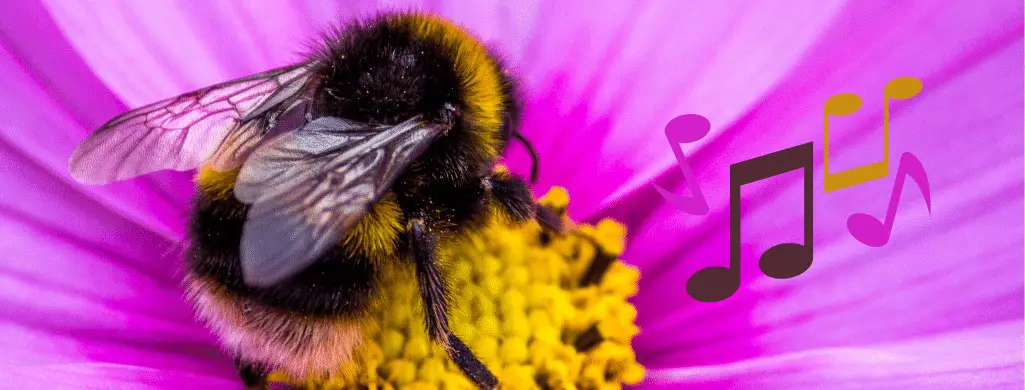I love using chants in my music classroom.
It helps the students get into the groove of making music (pun intended) without the self-conscious process of singing.
One of my absolute favorites for younger grades (Kindergarten, Preschool, and First Grade) is Bee Bee Bumblebee.
Today, I thought I’d give you a breakdown of this traditionally Kodaly chant and a couple of lesson plan ideas to go with it.
Let’s dig in!

Save time with these 60 FREE Music Resources to use in your room right away!
Stop searching the whole internet to find good activities. I’ll help you cut to the chase with my favorite 60 FREE resources.
Table of Contents
Bee Bee Bumblebee Sheet Music & Notation

Take a look at the chant above.
It’s pretty simple and catchy!
Essentially, all it is is a steady beat with quarter notes and eighth notes.
This makes it perfect for practicing the steady beat, and you can bring it back in 1st grade when you’re teaching those rhythm concepts.
Bee Bee Bumblebee Game
The game here with this song is super simple, and it’s quite fun!
- Students are sitting in a circle. One student starts with a ball, beanbag, or another object to pass around.
- Students pass the object to the steady beat around the circle.
- When the word “OUT” is said, the student who last had the object is now out.
- Repeat the chant until you have one person left.
I don’t often have the time nor do the students have the patience for this to go all the way around the room until every student is out.
So, I’ll often set a time limit and tell them that whoever is left at the end of the time is the winner, even if it’s half the class.
To keep the students who are OUT occupied, I’ll typically give them a non-pitched percussion instrument to play and keep the beat.
This reinforces the steady beat, engages the OUT children, and keeps the flow of music-making going!
Pro-tip: Set the expectation up front that YOU are the ultimate ref, and YOUR word is final. This way avoids some arguing (hopefully) when people are OUT.
Bee Bee Bumblebee Music Lesson Ideas
Aside from the standard pat-the-beat-while-saying-the-chant-steady-beat-practice, there are a few extensions one can do with their students.
Here are some of my quick ideas for you to implement right away!
Tempo Changing
The first idea and easiest to implement is to change the tempi of the chant.
In Kindergarten and early first grade music class, drawing contrast between different concepts is key.
Tempo, or the speed of the beat, is one of the most fun for kids.
Perform the song slow, medium, and fast.
Let the students decide when they’re OUT, which tempo you get to perform it at.
If you want to make it more random (and a bit more visually engaging), do a random picker.
I like this one at the Wheel of Names (also a great tool for picking random names!).

Dynamic Changing
Along the same lines, we can change dynamics.
You can even do the same idea I talked about before with tempo.
Another twist to incorporate is to have the students identify the dynamic level based on your (or a select student’s) performance of the chant.
This gives you a quick assessment for understanding this concept.
In Kindergarten, I don’t really introduce the actual musical terms for piano, mezzoforte, or forte, but you can if you want.
I usually just keep it with loud, medium, and soft.
Make up New Verses
The chant is short and simple, and it can serve as a great launching point for more verses to come!
I like to prompt the students with the following question as we compose new verse ideas:
- What animal or bug would you like to pick?
- What does that animal/bug do?
- Where can it “get” you?
- How can we rhyme with something to get someone out?
From here, teachers can guide the students in making new lyric ideas.
For example:
- Dog
- Bark
- Chase
- Run, Done
This could become:
Dog, dog, fuzzy dog
Like to bark upon a log.
He chased me so I had run.
I’m so tired now I’m done!
Arranging Steady Beat Patterns
As a way to introduce reading while still reinforcing a steady beat, I like to do what I call “Steady Beat Arrangements.”
This is where you take icons and place them in a specific order. Each icon is its own sound.
The students have to read the icons and perform the sounds when they show up all to a steady beat.
For example, in this chant, we could have two icons: a bee and a stinger.
When a student sees a bee, they say “buzz.”
When a student sees a stinger, they say “ow!”
Now, arrange the pictures in two rows of 4 (or some multiple of 8).
For example, I might do:
Bee Bee Bee Sting
Bee Bee Bee Sting
The students would say (to the beat):
Buzz buzz buzz ow!
Buzz buzz buzz ow!
Change the order and number of pictures to create new patterns.
Encourage the students to make up and arrange and perform their own!
Further Reading: Rhythm and beat activities for kindergarten

Save time with these 60 FREE Music Resources to use in your room right away!
Stop searching the whole internet to find good activities. I’ll help you cut to the chase with my favorite 60 FREE resources.

